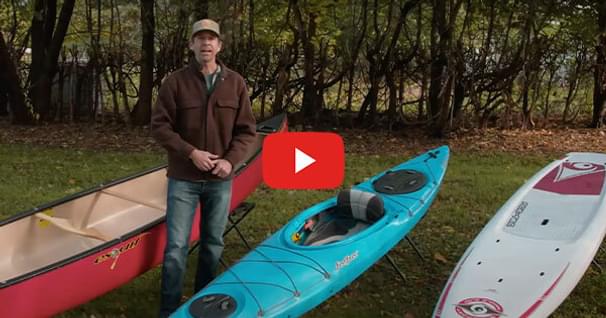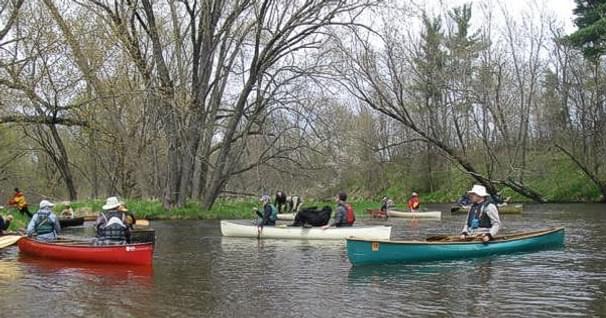Kayak Seaworthiness
Seaworthy: Fit for a Sea Voyage
I find certain words in the English language capture my interest. Seaworthy is one of them. My brain immediately breaks down the word to its obvious intent "worthy of the sea." Since we know how powerful the sea can be, being worthy of the sea is an impressive statement. How does the dictionary define seaworthy? My trusty Webster's Dictionary defines Seaworthy as:
fit or safe for a sea voyage.
I will eliminate the word safe from this definition because in my opinion safe on the sea is an oxymoron.
Even though the definition states sea voyage I will apply the definition to any craft that ventures onto the water. As I reviewed different definitions of the word seaworthy on-line, I saw that most of the definitions referred to a boat or craft. One usually associates seaworthiness to the vessel on the water (the object) not the pilot of the vessel. I think the definition should be expanded beyond that of just the kayak. I believe when one goes on the water for a paddle the boat and the paddler need to be seaworthy.
Let's first look at seaworthy as it applies to the kayak. I often say in my classes, "I believe the sea kayak is the most seaworthy boat in the world." I base my belief upon the ability of the sea kayak to capsize and roll back up and still be as functional as prior to the capsize.
One could use a simple definition for seaworthy as being able to float. However, I like the definition I found in Webster's; fit for a sea voyage. When I see the word "FIT," I think of outfit. This leads me to all that needs to be in or on a kayak when it is fully outfitted. How I outfit my kayak is depended upon the voyage I am undertaking. A quick two-hour paddle around the lake has different needs than a two-week expedition in Alaska. Even though the concept of seaworthiness is a conditional definition I have established my base line of seaworthiness for my kayak regardless of the conditions or the trip plan. I can add to this base line as needed but I will not go out on the water unless this base line is met.
Criteria of a Seaworthy Kayak
My base line seaworthy kayak has:
- Functional (non-leaking) bulkheads
- Proper bow & stern floatation if there are no bulkheads
- Secure bow & stern grab loops
- Sturdy deck lines
- Reliable hatch covers (keeps hatches dry)
- Good deck elastic lines (not worn out by UV rays)
- Paddle float
- Pump
- Spray skirt
- PFD
- Paddle
- Spare paddle when alone
- Repair kit
- Signal device(s)
The base line seaworthy kayak criteria will be added to according to the following:
- Type of paddling
- Location
- Conditions
- Paddling partners
- Duration of paddle
- My skill level
Paddler Seaworthiness
One of the consistent complaints I read about in club outings is the paddler that shows up for a paddle and their kayak does not meet the most minimum definition of seaworthy. The kayak floats but that is it. I believe that paddler is a liability to the group. I do not think it is unreasonable to set basic standards for group paddles. When there is a problem it is usually the prepared paddler dealing with the unprepared one.
The other part of being seaworthy in a kayak is the seaworthiness of the paddler. Since the paddler of a kayak can affect the stability and performance of the kayak I believe a discussion of this aspect is necessary. Skill level is a direct relationship to seaworthiness since a paddler becomes one with the kayak once they sit in the cockpit and secure their spray skirt. The boat and paddle become an extension of their body. In fact becoming one with the kayak is a common goal for competent paddlers. If a paddler is not physically and emotionally ready for their trip on the water then it will affect the overall seaworthiness of the kayak.
When I began my whitewater career I was nervous (excited & terrified) and I would tense up in the rapids. The higher my anxiety level the more I would capsize. I still recall my very first rapid. It was class II-III and I was anything but relaxed. Every rock and wave I hit was a near capsize. I was stiff in the torso. I also remember my first whitewater class as an instructor. I was going down that same rapid backwards while I watched my students. My kayak moved with the water and responded to any changes in stability because I was relaxed in my torso. The difference was my mental state. This relaxation was a result of training and experience. I can honestly say my kayak and me were both seaworthy. During my first trip down the rapid my kayak may have been seaworthy but I certainly was not.
Factors that can affect your personal seaworthiness:
- The anxiety of challenging conditions
- Your health (Are you feeling well?)
- Fear of capsizing
- Getting sea sick
- Difficulties at home or at work
- Fatigue and soreness
- Hunger & thirst
- Being cold, wet or too hot
- Wind
- Waves
- Current
- Rain &/or fog
- Day vs night
- Being lost
- Relationship issues
- Not feeling skilled enough
- An unstable kayak
I am sure you can add more to your own list. The key is to know when you should be on the water and when you should go hiking instead. You need to evaluate what type of paddling you and your kayak are ready to tackle. If you are planning on going out in rough conditions you should be feeling energized and ready for the challenge. If it is an off day then a gentle paddle may be in order. In fact, I often use a gentle paddle to help my mental state.
As an instructor and guide I know I have to be physically and emotionally ready for the group. If I cannot be there at that required level then I shouldn't be teaching or leading. During my 25 years of training outdoor leaders and instructors I have emphasized this very point. You and your kayak have to be seaworthy whenever you are in charge of a group.
Since I listed what is a minimum base line for my kayak being seaworthy I thought it only appropriate to list my baseline for me being seaworthy.
- Wanting to be there
- Feeling positive
- Feeling healthy with a clear head
- Knowing my equipment is appropriate for the conditions
- Having a plan
- Being nourished and hydrated
- Taken care of nature calls
- Believing my skills and experience are ready for the anticipated conditions
- Having back up plans
- Ready for emergencies
Your level of seaworthiness is always changing. As the day goes on and your body reacts to the conditions around you, your level of seaworthiness will change. I have to admit the most difficult challenge is when your level of seaworthiness drops after an unexpected challenge occurs and you are still on the water and have the rest of your planned paddle ahead of you. It can be an unexpected capsize because you looked down at a fish. The next thing you know, you are upside down in cold water. To add insult to injury your roll doesn't work which affects your self-confidence. If that isn't enough you forgot to leave you grab loop out and you had a slight panic attack when you couldn't find the loop. After finally wet exiting and getting back into your kayak after a successful capsize recovery you find your level of seaworthiness is not where it was before the capsize. How do you get it back?
The answer is a very personal one. What works for one paddler may not work for another. Therefore I will relate what has worked for me and for some others I have seen in similar circumstances. Rather than getting in the kayak and immediately paddling off, I found taking a few minutes to collect ones self is beneficial if conditions allow. Having someone stabilizing your kayak or using a paddle float allows you to move around without fear of another capsize. If a change of clothing is needed it is a good time to do it. Liquid and snacks also seem to help. A trick that works for me is exaggerating any tension I may be feeling. I will actually tense up my body as if I was doing a full body isometric exercise. Then I relax. I repeat the process about ten times. By doing so I lower my tension level. One time I actually tried loud screaming and grunting to reduce my tension (I was on a solo paddle at the time.) I must say that if you are one of those paddlers who likes to bring a thermos of hot chocolate there is almost nothing that isn't cured when you sip on that warm cup of chocolate. There have been times on rough days where my best salvation was going right back to paddling into the wind trying to get back into the groove of the workout.
When you feel your level of seaworthiness rising again then you can start paddling. If the challenge shook you up it is not uncommon to feel off for the rest of the paddle. There have been times when the trip plan was altered because attitudes changed. If you are like me the reason we are out there kayaking is for fun. If it is not fun maybe we should be off the water.
Before you go out on your next paddle think about what seaworthy means as it applies to your kayak and yourself. I would like you to consider adding seaworthiness to your checklist before you decide to go kayaking. Write down your own seaworthy criteria for your kayak and yourself. Keep your seaworthy criteria list around with your pre-paddle checklist of what to bring. If you can meet your base line needs of seaworthiness then it is a good day for a paddle. If not, think about ways of changing some of the factors so your level of seaworthiness is appropriate for your planned paddle. The question I ask before I go out is "am I and my kayak worthy of the sea today?"
Related Articles
Ken Whiting answers the big question for new paddlers - Do you go for a canoe, a kayak, or a stand up…
By changing how you edge and balance your boat you can increase your stability and adaptability. Using…
After the raw dimensions of length, width and depth, canoe performance is determined by hull shape.…
Earlier this year, a manufacturer of high-end composite canoes sponsored a weekend paddle down a local…




